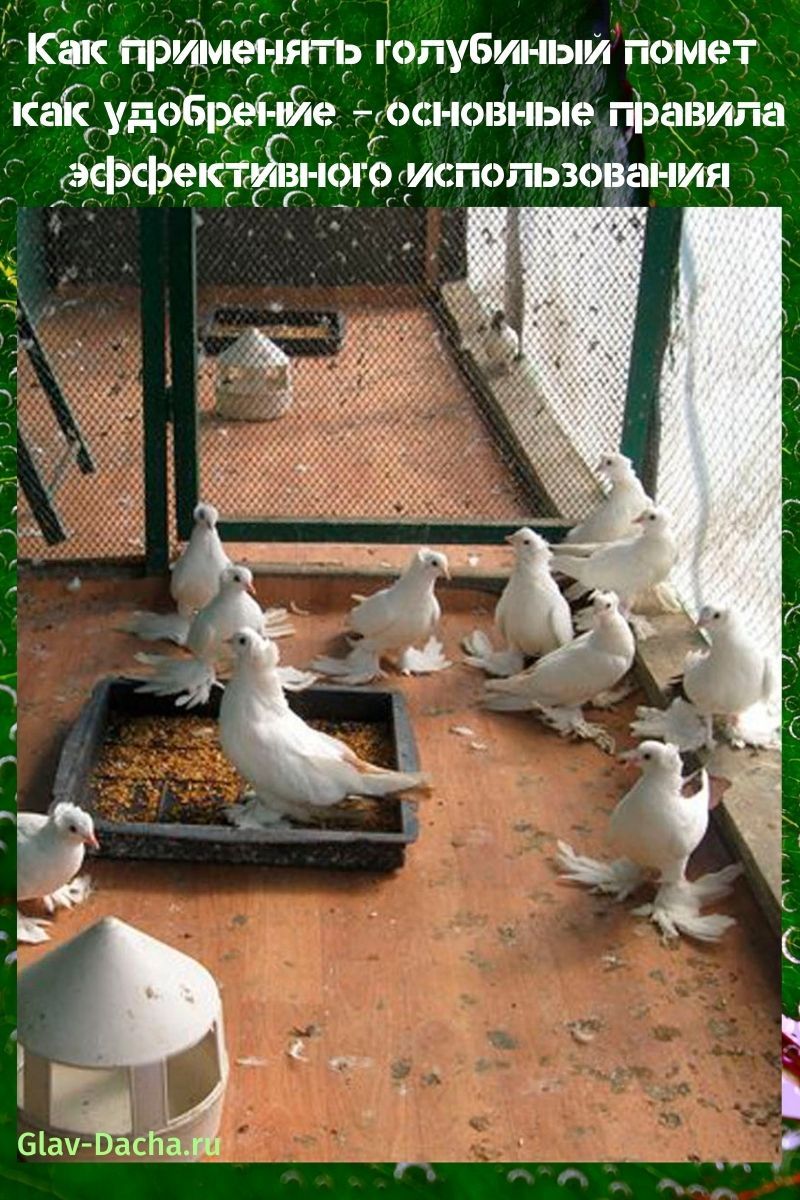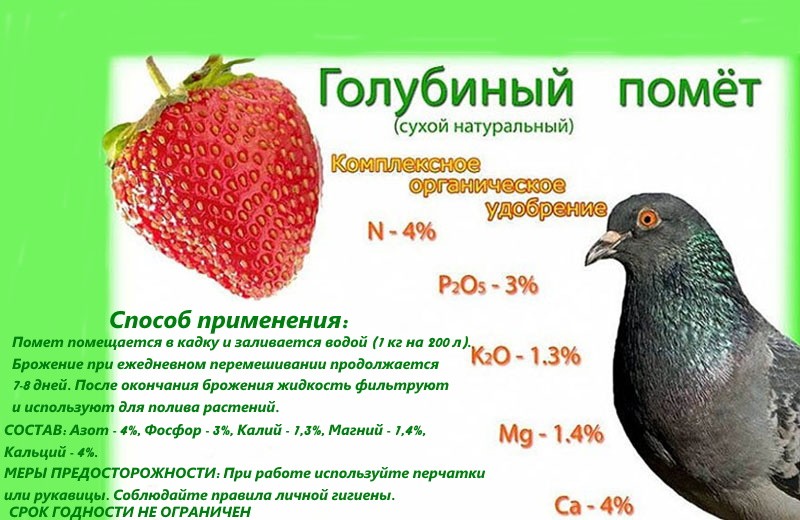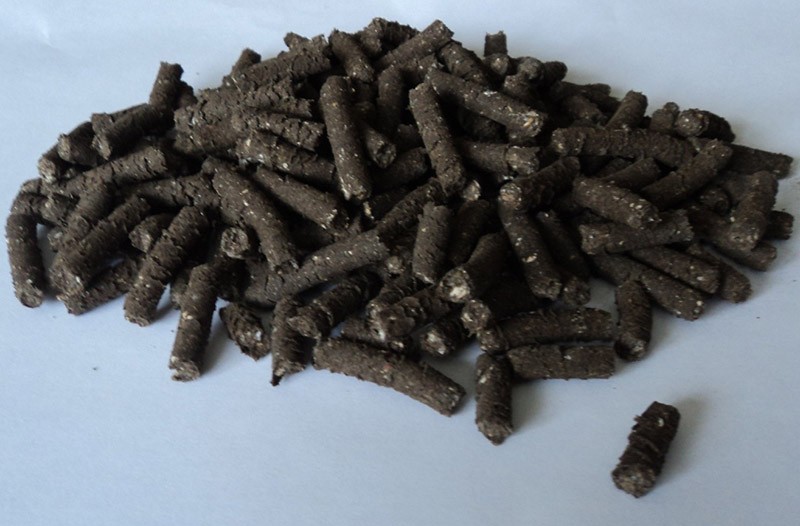How to use pigeon droppings as fertilizer - basic rules for effective use
 Pigeon droppings are not only the result of the vital activity of birds, but also a valuable organic fertilizer that improves the physicochemical characteristics of the soil and ensures high plant productivity. There are several ways to apply pigeon droppings as fertilizer. This valuable top dressing can be used for ornamental crops, garden crops and indoor plants.
Pigeon droppings are not only the result of the vital activity of birds, but also a valuable organic fertilizer that improves the physicochemical characteristics of the soil and ensures high plant productivity. There are several ways to apply pigeon droppings as fertilizer. This valuable top dressing can be used for ornamental crops, garden crops and indoor plants.
Pigeon droppings composition

Composition of pigeon droppings (per 100 g):
- zinc - 90 mg;
- copper - 40 mg;
- boron - 20 mg;
- manganese - 15 mg;
- cobalt - 15 mg.
Pigeon droppings contain phosphorus, nitrogen and potassium - the amount of these elements is almost three times more than in cow dung... Knowing how to apply fertilizer from pigeon droppings can improve the structure of the soil, accelerate the formation of humus, ensure the full development of plants and increase their productivity.
Methods for preparing fertilizer from manure
 Fertilizer from pigeon droppings cannot be applied to the soil in its pure form. This organic dressing takes a long time to decompose in the soil, and due to the high concentration of active substances, it can cause burns to the roots of plants.
Fertilizer from pigeon droppings cannot be applied to the soil in its pure form. This organic dressing takes a long time to decompose in the soil, and due to the high concentration of active substances, it can cause burns to the roots of plants.
To minimize the risk of psittacosis, only poultry droppings should be used.
Ways to use pigeon droppings for fertilization:
- dry dressing;
- liquid top dressing;
- ready-made granular preparations.
Pigeon droppings can be used to make compost. This will require a wide and high wooden box with slots at least 4-6 cm in size - they are necessary for full oxygen access.
 Pigeon droppings, chopped grass, peat, straw, fallen leaves should be poured into the box in layers. For accelerated composting, all layers should be watered with a special solution. The mixture must be constantly stirred - this will help the compost to mature much faster.
Pigeon droppings, chopped grass, peat, straw, fallen leaves should be poured into the box in layers. For accelerated composting, all layers should be watered with a special solution. The mixture must be constantly stirred - this will help the compost to mature much faster.
Dry dressing
 One way to prepare pigeon manure as fertilizer is by drying it. It helps to retain nitrogen and all biologically active substances contained in fresh droppings. Drying in special ovens is considered the best option, but in their absence, it can be dried in natural conditions.
One way to prepare pigeon manure as fertilizer is by drying it. It helps to retain nitrogen and all biologically active substances contained in fresh droppings. Drying in special ovens is considered the best option, but in their absence, it can be dried in natural conditions.
After that, the dried dressing must be crushed to a powdery state, stored in fabric or paper bags, and other sealed containers.
How to apply dry pigeon manure fertilizer:
- potatoes and other root crops - 50 g of dry powder per 1 sq. m when landing;
- young fruit trees - 4-5 kg per season;
- adult fruit trees - 10-15 kg per season.
Dry pigeon droppings can be used both in autumn and spring. The powder must be added to the trunk circle and covered with a layer of soil at least 8-12 cm high.
Liquid top dressing
 Liquid feeding is considered to be more nutritious and effective than dry manure.When using it, you can get a noticeable positive result much faster, but it is very important to observe proportions so as not to burn the plants.
Liquid feeding is considered to be more nutritious and effective than dry manure.When using it, you can get a noticeable positive result much faster, but it is very important to observe proportions so as not to burn the plants.
How to breed pigeon droppings for fertilization:
- Pour dried pigeon droppings into a bucket;
- mix with water in a ratio of 1:10;
- to increase efficiency, you can add a tablespoon of superphosphate and 2 tablespoons of ash to the top dressing;
- leave the container with fertilizer for infusion for 14 days;
- the fertilizer must be mixed daily.
Liquid fertilizer can be applied to the soil in the autumn and spring months, once every 15 days. Top dressing is best done in the early morning or evening, trying not to get liquid on the leaves and shoots of plants.
After applying a liquid solution of pigeon droppings, you need to water the soil and plants abundantly.
How to use pigeon droppings as fertilizer
 Pigeon manure as a fertilizer is best suited for black soil and loamy soil. When applied to clay soil, it is necessary to sand it first.
Pigeon manure as a fertilizer is best suited for black soil and loamy soil. When applied to clay soil, it is necessary to sand it first.
Organic fertilizing (pigeon droppings) is not used for sandy and limestone soils - in the first case, it will be ineffective due to a lack of moisture, in the second it will start to release ammonia.
Fertilization with pigeon droppings has a long-term effect, increasing the yield of crops grown for 3-4 years. Moreover, in the first year, the fruiting of crops increases to 65-70%.
Pigeon droppings can be used when digging a site in the fall. To do this, after harvesting, the soil should be fed with dried fertilizer in a proportion of 500-650 g per 1 sq. m. At the same time, the site is dug up to a depth of 12-15 cm.
Pigeon droppings are used for mulching garden and garden plants. This mulch can be used at any time of the year. But you need to make sure that there is a distance of at least 3-4 cm between the droppings and the lower leaves of the plants.
Fertilizing potatoes

Pigeon manure as a fertilizer for potatoes can be used in any form - liquid, dried, granular:
- Liquid top dressing - 1 kg of droppings, pour 2 buckets of water and leave to infuse for 2 weeks. Pour another bucket of water into the solution before use. Apply 0.5 L under potato bushes every 14 days.
- Dry digging - is introduced into the soil during spring digging at the rate of 50 g per 1 sq. m.
To fertilize potatoes, you can use compost with the addition of pigeon droppings. To do this, add 60-70 g of compost to each hole when planting.
Fertilizer tomato
 For active growth of green mass, tomatoes need a sufficient amount of nitrogen, phosphorus and potassium. Pigeon manure as fertilizer for tomatoes is used in the form of compost - it is applied in a glass to each planting hole. After that, mix the compost well with the soil and place the seedlings in it.
For active growth of green mass, tomatoes need a sufficient amount of nitrogen, phosphorus and potassium. Pigeon manure as fertilizer for tomatoes is used in the form of compost - it is applied in a glass to each planting hole. After that, mix the compost well with the soil and place the seedlings in it.
For the full growth and development of a tomato, a liquid infusion of pigeon droppings is used. To do this, under each tomato bush, 0.5 liters of liquid top dressing is applied.
White cabbage and cauliflower
 Feeding white cabbage from pigeon droppings is applied twice throughout the season. The first - 15-20 days after planting in the garden. To prepare fertilizer, mix 1 liter of liquid pigeon droppings with a bucket of water. To prevent a burn of the delicate root system, cabbage bushes should be watered a day before feeding.
Feeding white cabbage from pigeon droppings is applied twice throughout the season. The first - 15-20 days after planting in the garden. To prepare fertilizer, mix 1 liter of liquid pigeon droppings with a bucket of water. To prevent a burn of the delicate root system, cabbage bushes should be watered a day before feeding.
 Pigeon droppings are reintroduced in mid or late August. Later dressings are not recommended, as they can cause the accumulation of nitrates in cabbage heads and deterioration of their quality. You can add a spoonful of superphosphate to a bucket of fertilizer.
Pigeon droppings are reintroduced in mid or late August. Later dressings are not recommended, as they can cause the accumulation of nitrates in cabbage heads and deterioration of their quality. You can add a spoonful of superphosphate to a bucket of fertilizer.
Pigeon droppings can be used to feed not only white cabbage, but also cauliflower. Fertilizer is also applied twice a summer, but in a lower concentration - 0.5 liters of liquid pigeon droppings per bucket of water.
Re-feeding of cauliflower is best done after the size of the heads of cabbage reaches 2-3 cm. To do this, use a solution from a bucket of water, 0.5 liters of droppings and 1 tablespoon of superphosphate.
Strawberry
 The use of pigeon droppings helps to increase the yield of strawberries. To do this, strawberry beds can be fertilized with dried or liquid organic food. The first is more suitable for spring application, the second is more suitable for summer.
The use of pigeon droppings helps to increase the yield of strawberries. To do this, strawberry beds can be fertilized with dried or liquid organic food. The first is more suitable for spring application, the second is more suitable for summer.
Dry bird droppings for strawberries are used in the amount of 2 buckets per 1 sq. M. To prepare a liquid top dressing, mix 0.5 liters of liquid manure with a bucket of clean water.
Houseplants
 Pigeon droppings as a fertilizer for indoor plants can be used for garden and indoor flowers. This organic top dressing requires extra care. When watering, make sure that the solution does not get on the leaves and stems of plants, as this can lead to their burns.
Pigeon droppings as a fertilizer for indoor plants can be used for garden and indoor flowers. This organic top dressing requires extra care. When watering, make sure that the solution does not get on the leaves and stems of plants, as this can lead to their burns.
To saturate indoor plants with nitrogen and other useful substances, dry pigeon droppings are excellent. The solution is prepared from 1 part powder and 12 parts pure water. The prepared product must be immediately watered with indoor plants, it cannot be stored, since it loses almost all useful properties.
Pigeon droppings are a natural, effective supplement that can be used in the garden as well as in the garden. The competent use of organic fertilizers helps to improve the structure of the soil, increase its fertility, ensure the full development of plants and excellent yields for several years.